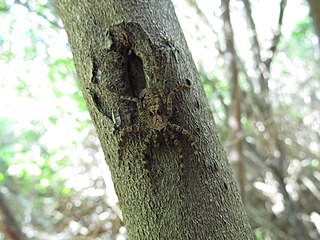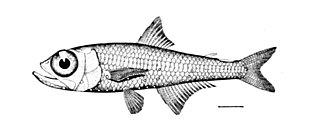
Theridiosoma is a genus of ray spiders that was first described by Octavius Pickard-Cambridge in 1879.
Schenkelia is a genus of jumping spiders that was first described by R. de Lessert in 1927.

Symphytognathidae is a family of spiders with 73 described species in eight genera. They occur in the tropics of Central and South America and the Australian region. Exceptions include Anapistula benoiti, Anapistula caecula, and Symphytognatha imbulunga, found in Africa, Anapistula ishikawai, found in Japan, and Anapistula jerai, found in Southeast Asia.

Tetrablemma is a widespread genus of armored spiders first described by Octavius Pickard-Cambridge in 1873. It only has four eyes; an unusual trait for spiders, found only here and in some species of Caponiidae, though the two are not closely related. The eyes are large, but unequal in size, closely grouped around the center of the prosoma that rises in a somewhat of a cone shape from the abdomen. They have four closely positioned spinnerets enclosed in a corneous casing.
Nesticella is a genus of spiders of the family Nesticidae. Most of its species are found in Asia—from Russia to Japan, down to Indonesia and several other islands, including New Guinea—though some species from Africa and South-America are also known. It includes a blind spider, Nesticella marapu.

Thomisus is a genus of crab spiders with around 150 species described. The genus includes species that vary widely in their ecology, with some that ambush predators that feed on insects visiting flowers. Like several other genera in the family Thomisidae, they are sometimes referred to as flower crab spiders, from their crab-like motion and their way of holding their front legs, reminiscent of a crab spreading its claws as a threat.

Babelomurex benoiti is a species of sea snail, a marine gastropod mollusk in the family Muricidae, the murex snails or rock snails.

Spiders are air-breathing arthropods that have eight legs, chelicerae with fangs generally able to inject venom, and spinnerets that extrude silk. They are the largest order of arachnids and rank seventh in total species diversity among all orders of organisms. Spiders are found worldwide on every continent except for Antarctica, and have become established in nearly every habitat with the exceptions of air and sea colonization. As of July 2019, at least 48,200 spider species, and 120 families have been recorded by taxonomists. However, there has been dissension within the scientific community as to how all these families should be classified, as evidenced by the over 20 different classifications that have been proposed since 1900.

Anapistula is a genus of dwarf orb-weavers that was first described by Carl Eduard Adolph Gerstaecker in 1941.
Andasta is a genus of ray spiders that was first described by Eugène Louis Simon in 1895.
Andasta benoiti is a species of ray spider that is endemic to the Seychelles. It is found on the islands of Mahé, Conception, Thérèse, North, Praslin, Marianne, Felicite and Denis. It is found in coastal woodlands. It is threatened by coastal development and habitat degradation from invasive plants, especially Cinnamomum verum.
Ceratinopsis is a genus of dwarf spiders that was first described by James Henry Emerton in 1882.
Pseudanapis is a genus of araneomorph spiders in the family Anapidae, first described by Eugène Simon in 1905. It is a senior synonym of "Gossiblemma" and "Amrishoonops".

Anyphops is a genus of wall spiders that was first described by P. L. G. Benoit in 1968.
Cyphalonotus is a genus of orb-weaver spiders first described by Eugène Simon in 1895.
Gastroxya is a genus of African orb-weaver spiders first described by Pierre L.G. Benoit in 1962.
Euprosthenops is a genus of nursery web spiders that was first described by Reginald Innes Pocock in 1897.
Nesioneta elegans is a species of sheet weaver spiders. It is found on the Caroline Islands and on Fiji.

The Benoit's lanternfish is a species of widespread oceanodromous lanternfish.








